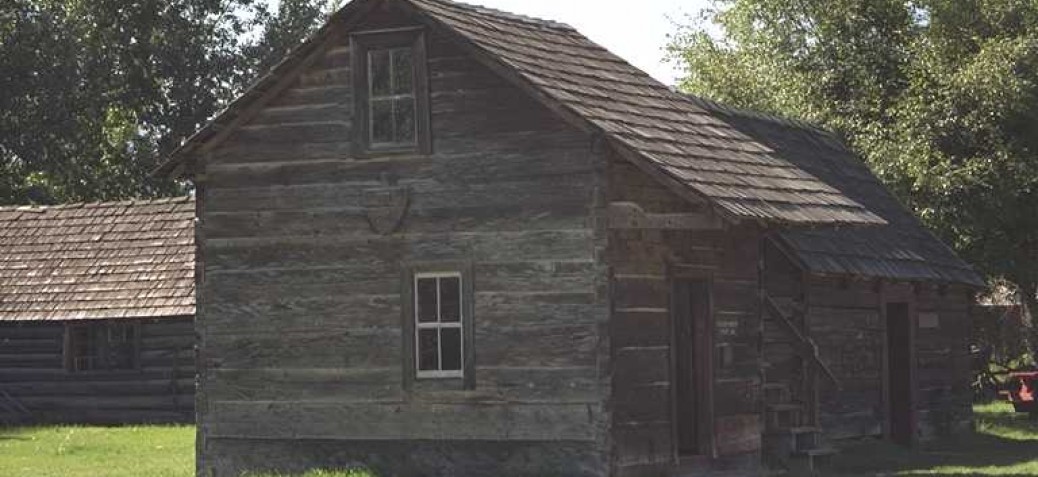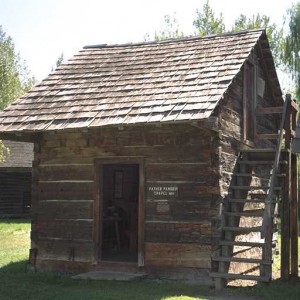Pandosy Misson Chapel
Place Description
The historic place is the 1.5-storey squared-log Pandosy Mission Chapel, perhaps built in 1860 as the first building in the building complex of the Mission of the Immaculate Conception (formerly known as the Okanagan Mission; and now called the Father Pandosy Mission, or simply Pandosy Mission), located at 3685 Benvoulin Road in Kelowna's Mission sector.
Heritage Value
The Pandosy Mission is often called the most important heritage resource in Kelowna; and the Chapel - one of only three buildings on the site that originated with the Mission and are in situ -is generally considered its principal structure. The Mission of the Immaculate Conception, located here by the Oblate Order in 1860, was the base for widespread missionary activity. As the first permanent white settlement in the Central Okanagan, it has a long list of 'firsts': first church; first school; first planting of fruit trees, grapes, and tobacco. For 30 years the Mission was the focus of settlement, until the Benvoulin and Kelowna townsites were laid out. The restored Pandosy Mission is now the largest and most respected heritage conservation site in the area.
The Mission has value for its association with Father Charles-Marie Pandosy. In 1859 Father Pandosy, Father Pierre Richard, and Brother Surel came to the Okanagan. Their first mission was at the south end of Duck Lake, but in 1860 they moved staked a claim here. Before winter Brother Surel built the first log building: a church, school, and mission house combined. It may be this building.
Other buildings were erected and the Mission became a substantial operation, the base for missionaries' ministrations to the Okanagan people between Kamloops and the U.S. border, Hope, and the Kootenay. Over the years they added more land; when the Mission property was sold in 1897 it comprised over 2,000 acres. The missionaries were on good terms with the fur-traders, who were mostly French-speaking Catholics, and the Mission was soon accompanied by a small settlement. The missionaries had only limited success in persuading Aboriginal children to attend their school, but by 1863 some settlers' children attended, taught in French by Father Richard. For 15 years this was the only school between Kamloops and the border.
Although many priests and lay brothers served at the Mission, it is Father Pandosy who is remembered and who has become a legendary figure. A large and powerfully built man, his energy drove the establishment. Although he was assigned elsewhere several times, he returned. His death at Penticton in January 1891 was the beginning of the end for the Mission. Railways and extensive white settlement in the southern Interior led to change in the Oblate focus. In 1896 the headquarters of the Oblates in the Interior shifted to Kamloops and the Okanagan Mission was closed. The property was sold in 1897 and broken up over time.
The building and the Okanagan Mission have value for the Okanagan Historical Society's having urged their preservation in the 1950s. In 1954 the Oblate Order bought a 2-acre parcel with 3 original buildings on it. The Kelowna Branch of the Okanagan Historical Society and the Father Pandosy Council of the Knights of Columbus began restoration. The Mission was rededicated in 1958 and opened to the public. Other buildings were moved onto the site for preservation and education purposes. In 1983 the Pandosy Mission was designated a Provincial Heritage Site.
The building, with a small upper floor and a 'verandah' formed by an extension of the roof, was built of squared logs, dove-tailed and keyed at the corners. It is one of the three original buildings on the site. It is called the 'Chapel', which would make it the first building constructed on the site in 1860. However, no documents substantiate the claim. The more than 50 years' use of the buildings as pigpens, chicken coops, and cattle stalls began makes identification difficult. A heritage consultant's report in 1981 suggested that, while certainly dating before 1869, the building might have been built slightly later than the neighbouring building. It notes, however, that some decorative details (particularly the remains of a wooden crest on the north side) suggest religious use and that the building may have served as a private chapel for the Oblate missionaries.
Character Defining Elements
- Vernacular log construction, with squared logs connected by dovetailed joints
- Gabled and shed roofs
- Part of the 10-building Okanagan Mission complex





